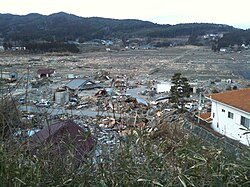
Kesen is a rural district in Iwate Prefecture, in the Tōhoku region of northern Japan.
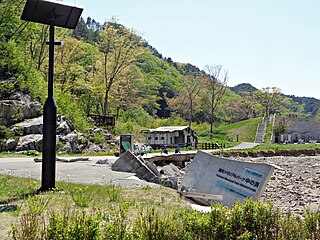
Miyako is a city located in Iwate Prefecture, Japan. As of 1 April 2020, the city had an estimated population of 51,150, and a population density of 41 persons per km2. The total area of the city is 1,259.15 square kilometers (486.16 sq mi).

Ōfunato is a city located in Iwate Prefecture, Japan. As of 30 April 2020, the city had an estimated population of 35,452, and a population density of 110 persons per km2 in 14,895 households. The total area of the city is 322.51 square kilometres (124.52 sq mi).
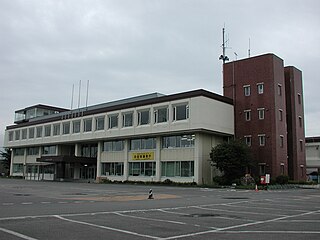
Kuji is a city in Iwate Prefecture, Japan. As of 3 March 2020, the city had an estimated population of 34,418 in 15,675 households, and a population density of 55 persons per km2. The total area of the city is 623.50 square kilometres (240.73 sq mi).

Kamaishi is a city located on the Sanriku rias coast in Iwate Prefecture, Japan. As of 31 March 2020, the city had an estimated population of 32,609, and a population density of 74 persons per km2, in 16,230 households. The total area of the city is 441.43 square kilometres (170.44 sq mi)

Ishinomaki is a city located in Miyagi Prefecture, Japan. As of 2 February 2022, the city has an estimated population of 138,538, and a population density of 250 persons per km2 in 61,919 households. The total area of the city is 554.55 square kilometres (214.11 sq mi).
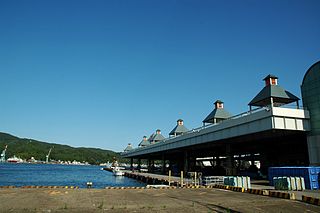
Kesennuma is a city in Miyagi Prefecture, Japan. As of 1 August 2020, the city had an estimated population of 59,803 and a population density of 190 inhabitants per square kilometre (490/sq mi) in 26,390 households. The total area of the city is 332.44 square kilometres (128.36 sq mi). Large sections of the city were destroyed by the 2011 Tōhoku earthquake and tsunami and major fires on March 11, 2011.

Tome is a city located in Miyagi Prefecture, Japan. As of 30 April 2020, the city had an estimated population of 77,897 and a population density of 150 persons per km2 in 27,298 households. The total area of the city is 536.12 square kilometres (207.00 sq mi). The area is noted for its rice production.

Onagawa is a town located in Miyagi Prefecture, Japan. As of 30 April 2020, the town had an estimated population of 6,319, and a population density of 97 persons per km2 in 3,110 households. The total area of the town is 65.35 square kilometres (25.23 sq mi).

Sumita is a town located in Iwate Prefecture, Japan. As of 31 July 2023, the town had a population of 4,977, and a population density of 15 persons per km2 in 2142 households. The total area of the town is 334.84 square kilometres (129.28 sq mi).

Yamada is a town in Iwate Prefecture, Japan. As of 1 May 2020, the town had an estimated population of 15,195 and a population density of 58 persons per km2, in 6,554 households. The total area of the town is 262.81 square kilometres (101.47 sq mi).

Tanohata is a village located in Iwate Prefecture, Japan. As of 1 May 2020, the village had an estimated population of 3,244, and a population density of 21 persons per km² in 1,398 households. The total area of the village is 156.19 square kilometres (60.31 sq mi).

Fudai is a village located in Iwate Prefecture, Japan. As of 1 June 2019, the village had an estimated population of 2,607, and a population density of 37.4 persons per km2 in 1,126 households. The total area of the village is 69.66 square kilometres (26.90 sq mi).

Rikuzen-Takata Station was a JR East railway station located in Rikuzentakata, Iwate Prefecture, Japan. The station, as well as most of the structures in the surrounding area, was destroyed by the 2011 Tōhoku earthquake and tsunami and has now been replaced by a bus rapid transit line.

Higashi-Matsushima is a city located in Miyagi Prefecture, Japan. As of 1 June 2020, the city had an estimated population of 39,580 in 16102 households, and a population density of 390 persons per km2. The total area of the city is 101.36 square kilometres (39.14 sq mi).
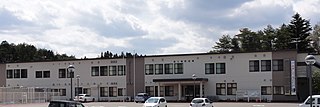
Minamisanriku is a town in Miyagi Prefecture, Japan. As of 1 May 2020, it had an estimated population of 12,516, and a population density of 77 persons per km2 in 4504 households. The total area of the town is 163.40 square kilometres (63.09 sq mi). It is a resort town on a coastline of wooded islands and mountainous inlets, large sections of which suffered from damage due to the 2011 Tōhoku earthquake and tsunami.

Takata Matsubara (高田松原) or Takata Pine Forest was a pine grove located on the Pacific seashore of the city of Rikuzentakata, Iwate Prefecture, Japan. It was designated a nationally designated Place of Scenic Beauty in 1940. and one of the 100 Landscapes of Japan during the Shōwa era. After the grove was destroyed during the 2011 Tōhoku earthquake and tsunami, tree planting efforts commenced in 2017 and 2018.

Lake Furukawanuma was a lake that existed in Rikuzentakata, Iwate, Japan until March 11, 2011. When the 2011 Tohoku earthquake struck, the resulting tsunami destroyed the sand wall that separated the lake from the sea. The lake's western edge thus became part of the new coastline, and the lake became part of the sea.

Sangojima (珊琥島) in an uninhabited islet located in the center of Ōfunato Bay, on the Sanriku Coast of Japan. It has been designated a National Place of Scenic Beauty and Natural Monument since 1946.

The Miracle Pine Tree was the lone surviving tree of the Takata Pine Forest, which suffered deadly damage from the Great East Japan Earthquake tsunami in March 2011. It was located in Rikuzentakata, Iwate Prefecture. Preserved as a permanent reminder of the Great East Japan Earthquake, it died shortly after the tsunami due to exposure to saltwater.


